标签:写入文件 set product 键值对 状态码 使用方法 Fix flag 表达
学习者需要预先掌握Python的数字类型、字符串类型、分支、循环、函数、列表类型、字典类型、文件和第三方库使用等概念和编程方法。

a. 发送请求
使用http库向目标站点发起请求,即发送一个Request,Request包含:请求头、请求体等。
Request模块缺陷:不能执行JS 和CSS 代码。
b. 获取响应内容
如果requests的内容存在于目标服务器上,那么服务器会返回请求内容。
Response包含:html、Json字符串、图片,视频等。
c. 解析内容
对用户而言,就是寻找自己需要的信息。对于Python爬虫而言,就是利用正则表达式或者其他库提取目标信息。
解析html数据:正则表达式(RE模块),第三方解析库如Beautifulsoup,pyquery等
解析json数据:json模块
解析二进制数据:以wb的方式写入文件
d. 保存数据
解析得到的数据可以多种形式,如文本,音频,视频保存在本地。
数据库(MySQL,Mongdb、Redis)
文件
Requests是用python语言基于urllib编写的,采用的是Apache2 Licensed开源协议的HTTP库。
安装:
Win平台:以“管理员身份运行cmd”,执行 pip install requests

测试:

| 方法 | 说明 |
| requests.request() | 构造一个请求,支撑一下个方法的基础方法。 |
| requests.get() | 获取HTML网页的主要方法,对应HTTP的GET |
| requests.head() | 获取HTML网页投信息的方法,对应HTTP的HEAD |
| requests.post() | 向HTML网页提交POST请求的方法,对应HTTP的POST |
| requests.put() | 向HTML网页提交PUT请求的方法,对应HTTP的PUT |
| requests.patch() | 向HTML网页提交局部修改请求,对应HTTP的PATCH |
| requests.delete() | 向HTML网页提交删除请求,对应HTTP的DELETE |
带可选参数的请求方式:
requests.request(method,url,**kwargs)
method:请求方式,对应get/put/post等7种
url:获取页面的url链接
**kwargs:控制访问的参数,均为可选项,共以下13个
params:字典或字节系列,作为参数增加到url中
>>> kv = {‘key1‘:‘value1‘,‘key2‘:‘value2‘}
>>> r = requests.request(‘GET‘,‘http://python123.io/ws‘,params=kv)
>>> print(r.url)
https://python123.io/ws?key1=value1&key2=value2
data:字典、字节系列或文件对象,作为requests的内容
>>> kv = {‘key1‘:‘value1‘,‘key2‘:‘value2‘}
>>> r = requests.request(‘POST‘,‘http://python123.io/ws‘,data=kv)
>>> body = ‘主题内容‘
>>> r = requests.request(‘POST‘,‘http:///python123.io/ws‘,data=body)
json:JSON格式的数据,作为equests的内容
>>> kv = {‘key1‘:‘value1‘,‘key2‘:‘value2‘}
>>> r = requests.request(‘POST‘,‘http://python123.io/ws‘,json=kv)
headers:字典,HTTP定制头
>>> hd = {‘user-agent‘:‘Chrome/10‘}
>>> r = requests.request(‘POST‘,‘http://www.baidu.com‘,headers=hd)
cookies:字典或cookieJar,Request中的cookie
files:字典类型,传输文件
>>> f = {‘file‘:open(‘/root/po.sh‘,‘rb‘)}
>>> r = requests.request(‘POST‘,‘http://python123.io/ws‘,file=f)
timeout:设置超时时间,秒为单位。
>>> r = requests.request(‘GET‘,‘http://python123.io/ws‘,timeout=30)
proxies:字典类型,设置访问代理服务器,可以增加登录验证。
>>> pxs = {‘http‘:‘http://user:pass@10.10.10.2:1234‘,
... ‘https‘:‘https://10.10.10.3:1234‘}
>>> r = requests.request(‘GET‘,‘http://www.baidu.com‘,proxies=pxs)
allow_redirects:True/False,默认为True,重定向开关
stream:True/False,默认为True,获取内容立即下载开关
verify:rue/False,默认为True,认证SSL证书开关
Cert:本地SSL证书路径
auth:元组类型,支持HTTP认证功能
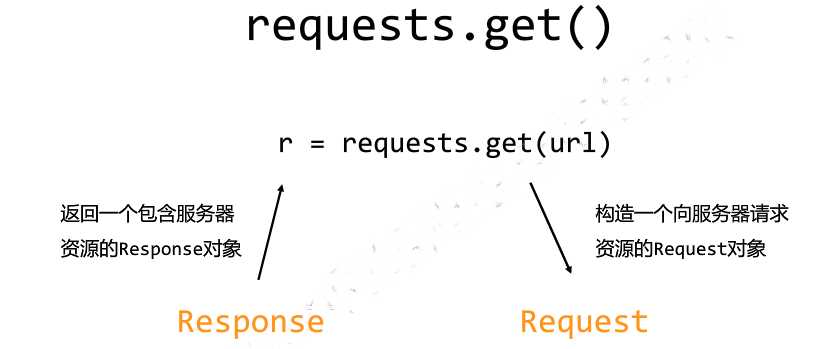

Response对象包含服务器返回的所有信息,也包含请求的Request信息



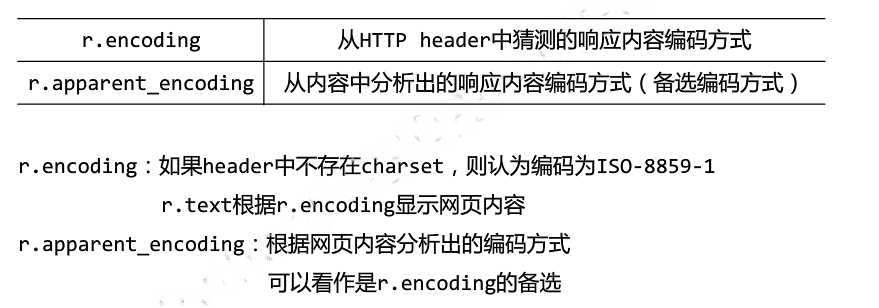
注意:编码为ISO-8859-1不支持编译中文,需要设置 r = encoding="utf-8"
Requests库支持常见的6种连接异常

注意:网络连接有风险。异常处理很重要。raise_for_status()如果不等于200则产生异常requests.HTTPError。
import requests def getHTMLText(url): try: r = requests.get(url,timeout=30) r.raise_for_status() r.encoding = r.apparent_encoding return r.text except: return "产生异常" if __name__ == "__main__": url = "http://www.baidu.com" print(getHTMLText(url))
robots是网站跟爬虫间的协议,robots.txt(统一小写)是一种存放于网站根目录下的ASCII编码的文本文件,它通常告诉网络搜索引擎的漫游器(又称网络蜘蛛),此网站中的哪些内容是不应被搜索引擎的漫游器获取的,哪些是可以被漫游器获取的。因为一些系统中的URL是大小写敏感的,所以robots.txt的文件名应统一为小写。robots.txt应放置于网站的根目录下。
网络爬虫的尺寸:

a. 网络爬虫的“性能”骚扰
web默认接受人类访问,由于网络爬虫的频繁访问会给服务器带来巨大的额资源开销。
b. 网络爬虫的法律风险
服务器上的数据有产权归属,网络爬虫获取数据牟利将带来法律风险
c. 网络爬虫的隐私泄露
网络爬虫可能具备突破简单控制访问的能力,获取被保护的数据从而泄露个人隐私。
a. 来源审查:判断User-Agent进行限制
检查来访HTTP协议头的user-agent域,只响应浏览器或友好爬虫的访问
b. 发布公告:Robots协议
告知所有爬虫网站的爬取策略,要求遵守Robots协议
京东的Robots协议:
https://www.jd.com/robots.txt
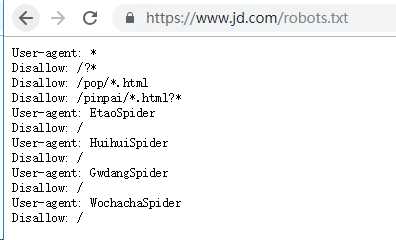
#注释,*代表所有,/代表根目录
对robots协议的理解

自动或人工识别roboes.txt,z再进行内容爬取。
robots协议是建议但非约束性,网络爬虫可以补遵守,但存在法律风险。
原则:人类行为可以补参考robots协议,比如正常阅览网站,或者较少爬取网站频率。
目标页面地址:https://item.jd.com/5089267.html

实例代码:
import requests url = ‘https://item.jd.com/5089267.html‘ try: r = requests.get(url) r.raise_for_status() r.encoding =r.apparent_encoding print(r.text[:1000]) except: print("爬取失败")
结果:

目标页面地址:http://product.dangdang.com/26487763.html

代码:
import requests url = ‘http://product.dangdang.com/26487763.html‘ try: r = requests.get(url) r.raise_for_status() r.encoding =r.apparent_encoding print(r.text[:1000]) except IOError as e: print(str(e))
出现报错:
HTTPConnectionPool(host=‘127.0.0.1‘, port=80): Max retries exceeded with url: /26487763.html (Caused by NewConnectionError(‘<urllib3.connection.HTTPConnection object at 0x10fc390>: Failed to establish a new connection: [Errno 111] Connection refused‘,))
报错原因:当当网拒绝不合理的浏览器访问。
查看初识的http请求头:
print(r.request.headers)

代码改进:构造合理的HTTP请求头
import requests url = ‘http://product.dangdang.com/26487763.html‘ try: kv = {‘user-agent‘:‘Mozilla/5.0‘} r = requests.get(url,headers=kv) r.raise_for_status() r.encoding =r.apparent_encoding print(r.text[:1000]) except IOError as e: print(str(e))
结果正常爬取:

百度关键词接口:http://www.baidu.com/s?wd=keyword
代码实现:
import requests keyword = "python" try: kv = {‘wd‘:keyword} r = requests.get("http://www.baidu.com/s",params=kv) print(r.request.url) r.raise_for_status() print(len(r.text)) except IOError as e: print(str(e))
执行结果:

360关键词接口:
http://www.so.com/s?q=keyword
代码实现:
import requests keyword = "Linux" try: kv = {‘q‘:keyword} r = requests.get("http://www.so.com/s",params=kv) print(r.request.url) r.raise_for_status() print(len(r.text)) except IOError as e: print(str(e))
执行结果:

网络图片链接的格式:
http://FQDN/picture.jpg
校花网:http://www.xiaohuar.com
选择一个图片地址:http://www.xiaohuar.com/d/file/20141116030511162.jpg
实现代码:
import requests import os url = "http://www.xiaohuar.com/d/file/20141116030511162.jpg" dir = "D://pics//" path = dir + url.split(‘/‘)[-1] #设置图片保存路径并以原图名名字命名 try: if not os.path.exists(dir): os.mkdir(dir) if not os.path.exists(path): r = requests.get(url) with open(path,‘wb‘) as f: f.write(r.content) f.close() print("文件保存成功") else: print("文件已存在") except IOError as e: print(str(e))
查看图片已经存在:

5.5 ip地址归属地查询
ip地址归属地查询网站接口:http://www.ip138.com/ips138.asp?ip=
实现代码:
import requests url = "http://www.ip38.com/ip.php?ip=" try: r = requests.get(url+‘104.193.88.77‘) r.raise_for_status() r.encoding = r.apparent_encoding print(r.text) except IOError as e: print(str(e))
from bs4 import BeautifulSoup soup = BeautifulSoup(‘<p>Hello</p>‘,‘lxml‘) print(soup.p.string)
>>> from bs4 import BeautifulSoup >>> import requests >>> r = requests.get("http://python123.io/ws/demo.html") >>> demo = r.text >>> demo ‘<html><head><title>This is a python demo page</title></head>\r\n<body>\r\n<p class="title"><b>The demo python introduces several python courses.</b></p>\r\n<p class="course">Python is a wonderful general-purpose programming language. You can learn Python from novice to professional by tracking the following courses:\r\n<a href="http://www.icourse163.org/course/BIT-268001" class="py1" id="link1">Basic Python</a> and <a href="http://www.icourse163.org/course/BIT-1001870001" class="py2" id="link2">Advanced Python</a>.</p>\r\n</body></html>‘ >>> soup = BeautifulSoup(demo,"html.parser") >>> soup.title #获取标题 <title>This is a python demo page</title> >>> soup.a #获取a标签 <a class="py1" href="http://www.icourse163.org/course/BIT-268001" id="link1">Basic Python</a> >>> soup.title.string ‘This is a python demo page‘ >>> soup.prettify() #输出html标准格式内容 ‘<html>\n <head>\n <title>\n This is a python demo page\n </title>\n </head>\n <body>\n <p class="title">\n <b>\n The demo python introduces several python courses.\n </b>\n </p>\n <p class="course">\n Python is a wonderful general-purpose programming language. You can learn Python from novice to professional by tracking the following courses:\n <a class="py1" href="http://www.icourse163.org/course/BIT-268001" id="link1">\n Basic Python\n </a>\n and\n <a class="py2" href="http://www.icourse163.org/course/BIT-1001870001" id="link2">\n Advanced Python\n </a>\n .\n </p>\n </body>\n</html>‘ >>> soup.a.name #每个<tag>都有自己的名字,通过<tag>.name获取 ‘a‘ >>> soup.p.name ‘p‘ >>> tag = soup.a >>> tag.attrs {‘href‘: ‘http://www.icourse163.org/course/BIT-268001‘, ‘class‘: [‘py1‘], ‘id‘: ‘link1‘} >>> tag.attrs[‘class‘] [‘py1‘] >>> tag.attrs[‘href‘] ‘http://www.icourse163.org/course/BIT-268001‘ >>> type(tag.attrs) <class ‘dict‘> >>> type(tag) <class ‘bs4.element.Tag‘> >>>
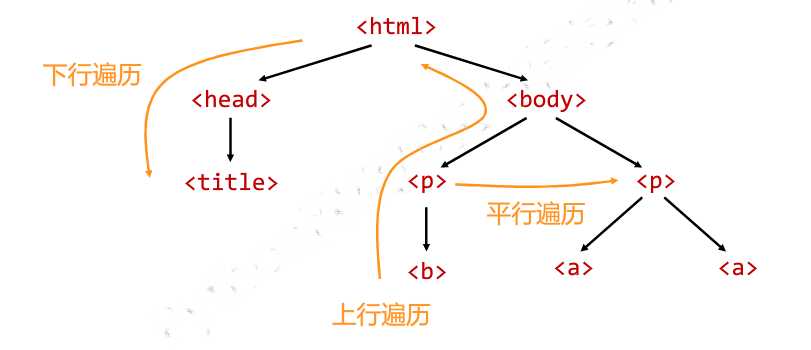




from bs4 import BeautifulSoup import requests demo = requests.get("http://python123.io/ws/demo.html").text soup = BeautifulSoup(demo,"html.parser") #标签树的上行遍历 print("遍历儿子节点:\n") for child in soup.body.children: print(child) print("遍历子孙节点:\n") for child1 in soup.body.descendants: print(child1) print(soup.title.parent) print(soup.html.parent) for parent in soup.a.parents: if parent is None: print(parent) else: print(parent.name) #标签树的平行遍历 print(soup.a.next_sibling) print(soup.a.next_sibling.next_sibling) print(soup.a.previous_sibling)
正则表达式是处理字符串的强大工具,它有自己特定的语法结构,实现字符串的检索、替换、匹配验证都可以。对于爬虫来说,
从HTML里提取想要的信息非常方便。python的re库提供了整个正则表达式的实现
这里介绍一个正则表达式测试工具http://tool.oschina.net/regex,输入待匹配的文本,然选择常用的正则表达式,得到相应的匹配结果,
适合新手入门。这里输入:
hello,my phone is 18898566588 and email is david@gmail.com, and wen is https://www.cnblogs.com/wenwei-blog/
点击“匹配Email地址”,即可匹配出网址。
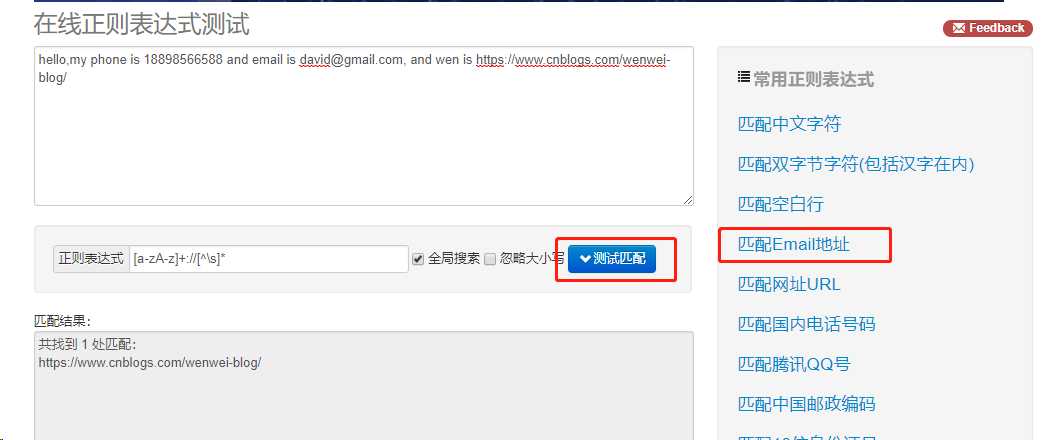
|
方法/属性
|
作用
|
|
re.match(pattern, string, flags=0)
|
从字符串的起始位置匹配,如果起始位置匹配不成功的话,match()就返回none
|
|
re.search(pattern, string, flags=0)
|
扫描整个字符串并返回第一个成功的匹配
|
|
re.findall(pattern, string, flags=0)
|
找到RE匹配的所有字符串,并把他们作为一个列表返回
|
|
re.finditer(pattern, string, flags=0)
|
找到RE匹配的所有字符串,并把他们作为一个迭代器返回
|
|
re.sub(pattern, repl, string, count=0, flags=0)
|
替换匹配到的字符串
|
#!/usr/bin/python3 import re #替换 phone = ‘18898537584 #这是我的电话号码‘ print(‘我的电话号码:‘,re.sub(‘#.*‘,‘‘,phone)) #去掉注释 print(re.sub(‘\D‘,‘‘,phone)) #search ip_addr = re.search(‘(\d{3}\.){1,3}\d{1,3}\.\d{1,3}‘,os.popen(‘ifconfig‘).read()) print(ip_addr) #match >>> a = re.match(‘\d+‘,‘2ewrer666dad3123df45‘) >>> print(a.group()) 2
>>> import re >>> print(re.search(r‘(\d+)-([a-z])‘,‘34324-dfsdfs777-hhh‘).group(0)) #返回整体 34324-d >>> print(re.search(r‘(\d+)-([a-z])‘,‘34324-dfsdfs777-hhh‘).group(1)) #返回第一组 34324 >>> print(re.search(r‘(\d+)-([a-z])‘,‘34324-dfsdfs777-hhh‘).group(2)) #获取第二组 d >>> print(re.search(r‘(\d+)-([a-z])‘,‘34324-dfsdfs777-hhh‘).group(3)) #不存在。报错“no such group” Traceback (most recent call last): File "<stdin>", line 1, in <module> IndexError: no such group
compile 函数用于编译正则表达式,生成一个正则表达式( Pattern )对象。语法格式:
re.compile(pattern[, flags])
参数:
pattern : 一个字符串形式的正则表达式
flags : 可选,表示匹配模式,比如忽略大小写,多行模式等,具体参数为:
re.I 忽略大小写
re.L 表示特殊字符集 \w, \W, \b, \B, \s, \S 依赖于当前环境
re.M 多行模式
re.S 即为 . 并且包括换行符在内的任意字符(. 不包括换行符)
re.U 表示特殊字符集 \w, \W, \b, \B, \d, \D, \s, \S 依赖于 Unicode 字符属性数据库
re.X 为了增加可读性,忽略空格和 # 后面的注释
常用的是re.I和re.S
>>> import re >>> pattern = re.compile(‘\d+‘,re.S) #用于匹配至少一个数字 >>> res = re.findall(pattern,"my phone is 18898566588") >>> print(res) [‘18898566588‘]
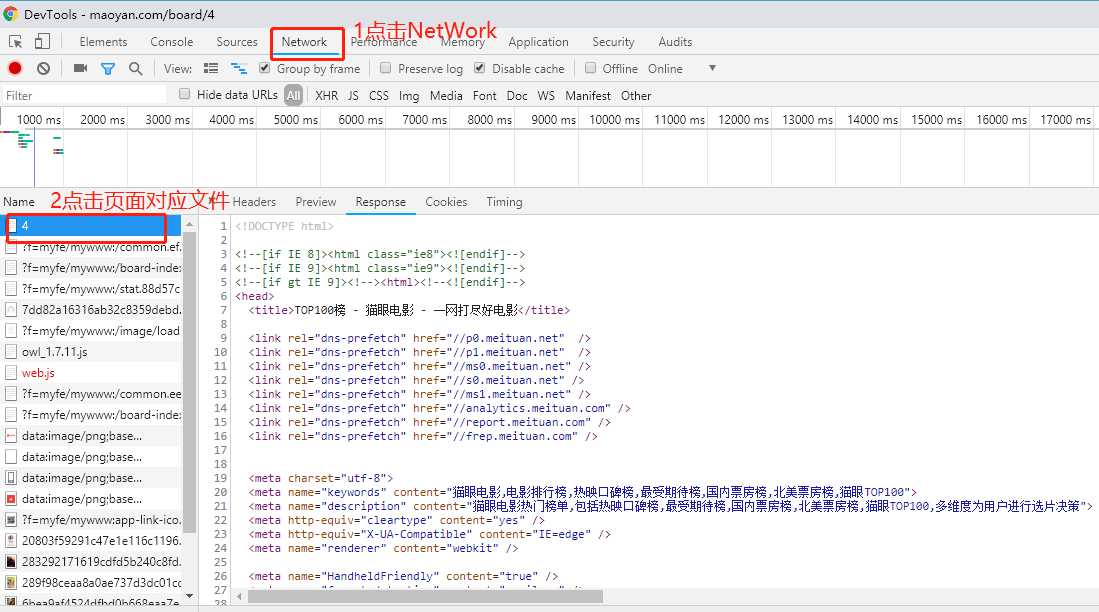

代码整合
import json import requests from requests.exceptions import RequestException #引入异常 import re import time def get_one_page(url): try: response = requests.get(url) if response.status_code == 200: #由状态码判断返回结果 return response.text #返回网页内容 return None except RequestException: return None def parse_one_page(html): pattern = re.compile(‘<dd>.*?board-index.*?>(\d+)</i>.*?data-src="(.*?)".*?name"><a‘ + ‘.*?>(.*?)</a>.*?star">(.*?)</p>.*?releasetime">(.*?)</p>‘ + ‘.*?integer">(.*?)</i>.*?fraction">(.*?)</i>.*?</dd>‘, re.S) #compile函数表示一个方法对象,re.s匹配多行 items = re.findall(pattern, html) #以列表形式返回全部能匹配的字符串。 for item in items: #将结果以字典形式返回键值对 yield { #把这个方法变成一个生成器 ‘index‘: item[0], ‘image‘: item[1], ‘title‘: item[2], ‘actor‘: item[3].strip()[3:], ‘time‘: item[4].strip()[5:], ‘score‘: item[5] + item[6] #将评分整数和小数结合起来 } def write_to_file(content): with open(‘result.txt‘, ‘a‘, encoding=‘utf-8‘) as f: #将结果写入文件 f.write(json.dumps(content, ensure_ascii=False) + ‘\n‘) def main(offset): url = ‘http://maoyan.com/board/4?offset=‘ + str(offset) html = get_one_page(url) for item in parse_one_page(html): print(item) write_to_file(item) if __name__ == ‘__main__‘: for i in range(10): main(offset=i * 10) time.sleep(1)
未完待续!
标签:写入文件 set product 键值对 状态码 使用方法 Fix flag 表达
原文地址:https://www.cnblogs.com/wenwei-blog/p/10435602.html